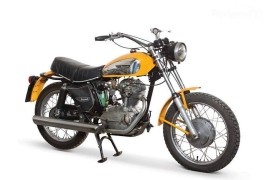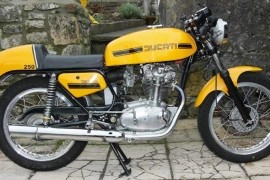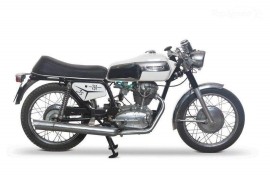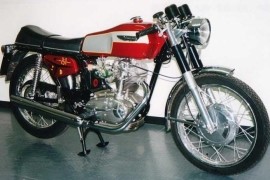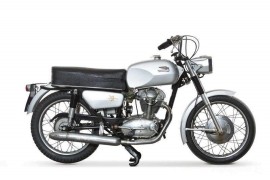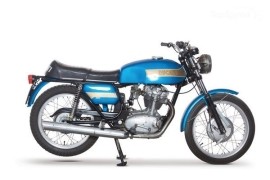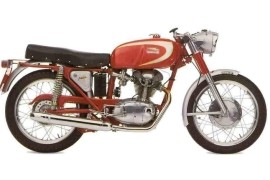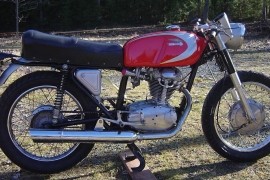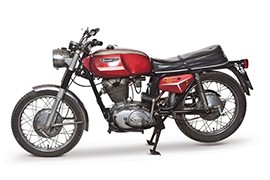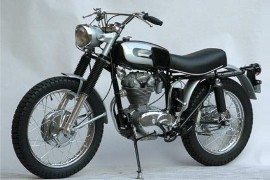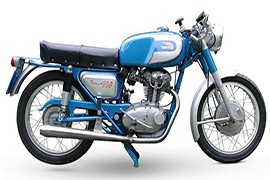DUCATI 250 Models/Series Timeline, Specifications & Photos
First production year: 1961
The 1972 Ducati 250 Scrambler had standard fittings such as a hydraulic telescopic front fork, the dual shock absorber rear suspension, a steel frame, a chromed exhaust system, drum brakes in the front and in the rear, a single seat an analogue instrumentation panel and a small, round headlight. In the engine department, it came equipped with an air-cooled, four-stroke, 249cc, desmodromic single cylinder powerplant that was paired to a five-speed manual transmission and could reach a maximum power output of 18 horsepower at 7500 rpm.
The 1971 Ducati 250 Desmo sports an air-cooled, four-stroke, 249cc, single cylinder desmodromic powerhouse mated to a five-speed manual transmission. It also comes with a chromed exhaust system, a steel frame, a telescopic front fork, dual shocks as a rear suspension, a single seat, laced wheels, a small headlight, an analogue instrumentation panel, narrow handlebars and a drum braking system.
The 1970 Ducati 250 Mark 3D Desmo had, at its heart, an air-cooled, four-stroke, 249cc, single cylinder powerhouse mated to a five-speed manual transmission and could produce a claimed 28 horsepower at 8500 rpm. Also, it had fittings such as laced wheels, a dual seat, a round headlight, an analogue instrument cluster, a chromed exhaust system, a center stand, drum brakes in the front as well as in the rear and a suspension package composed of a hydraulic telescopic front fork and dual shocks in the rear.
The 1969 Ducati 250 Mark 3D Desmo is one of the first machines from Borgo Panigale to be equipped with a desmodromic engine, and was one of the most sought after machines in its time. It comes with features such as laced wheels, a dual seat, a round headlight, an analogue instrument cluster, a chromed exhaust system, a center stand, drum brakes in the front as well as in the rear and a suspension package composed of a hydraulic telescopic front fork and dual shocks in the rear.
In the engine department it sports an air-cooled, four-stroke, 249cc, single cylinder powerplant paired to a five-speed manual transmission that can reach a maximum power output of 28 horsepower at 8500 rpm.
The 1968 Ducati 250 Monza was inspired by the 250 F3 Racer rode by Franco Villa in official races. It had, at its heart, an air-cooled, four-stroke, 249cc, single cylinder desmodromic engine mated to a five-speed manual transmission, and could produce a claimed 21 horsepower at 7200 rpm.
Also, it had standard features such as a drum braking system both in the front and in the rear, pull-back handlebars, a dual seat, laced wheels, a chromed exhaust system, a suspension package composed of a hydraulic telescopic fork in the front and dual shocks in the rear, a center stand and a small, round headlight.
The 1967 Ducati 250 Diana Mark III has, at its heart, an air-cooled, four-stroke, 249cc, single cylinder powerhouse paired to a five-speed manual transmission and can produce a claimed 20 horsepower at 7750 rpm.
Standard features include a hydraulic telescopic front fork, dual shocks as a rear suspension, a drum braking system both in the front and in the rear, a small headlight, a steel frame, laced wheels, a dual seat, analogue instrumentation dials and a chromed exhaust system.
The 1966 MY Ducati 250 Mark 1 is a classic, middleweight machine that had features such as a hydraulic telescopic fork, dual shocks in the rear, front and rear drum brakes, a dual seat, a steel frame, laced wheels, a small, round headlight, clip-on handlebars and a chromed exhaust system. In the engine department, it sports an air-cooled, four-stroke, 249cc, single cylinder desmodromic engine paired to a five-speed manual transmission and could reach a maximum power output of 28 horsepower at 8500 rpm.
The 1964 Ducati 250 Diana sports an air-cooled, four-stroke, 249cc, single cylinder powerplant paired to a four-speed manual transmission and can produce a claimed 20 horsepower at 7750 rpm. Also, it comes with features such as a small, round headlight, a chromed exhaust system with dual mufflers, a center stand, laced wheels, drum brakes in the front as well as in the rear, analogue instrumentation dials and a suspension package composed of a hydraulic telescopic front fork and dual shocks in the rear.
The Ducati Diana Mark 3 was a sports motorcycle also known as the Ducati Diana Super Sport. The bike was manufactured in 1962 as a replacement model for the Ducati Diana and produced until 1966 when it was replaced by the Ducati 250 Mark 3.
It was a higher-performance version of the Ducati Diana, powered by a 249cc single-cylinder bevel drive SOHC engine, and was sold only in the American market. In 1963, the bike was described by Cycle Magazin as the fastest and smoothest standard motorcycle in the 250cc class.
In 1962, the Italian motorcycle manufacturer launched the Ducati 250 Diana Mark 3, a sports machine fitted with standard elements, such as a round headlight up front, a large fuel tank, a one-piece dual seat with a passenger strap handle, side-mounted rear shocks, a single exhaust system, and wire-spoke wheels.
The bike's suspension system comprised a 31,5 mm telescopic fork on the front and a swingarm coupled to twin three-way-adjustable shock absorbers on the rear, providing optimum handling capabilities.
The braking performance was achieved by a 180 mm drum braking unit on the front wheel and a 160 mm drum unit on the rear wheel, offering optimum stopping performance.
As for the power figures, the 1962 Ducati 250 Diana Mark 3 had installed a 249cc four-stroke single-cylinder air-cooled engine underneath its fuel tank, boasting 20 hp with a peak force at 8,300 rpm.
The 1962 Ducati 250 Scrambler was one of the most sought after two-wheelers at its time, and had, at its heart, an air-cooled, four-stroke, 249cc, single cylinder desmodromic engine paired to a five-speed manual transmission. Features worth mentioning for this machine would be the hydraulic telescopic front fork, the dual shock absorber rear suspension, a steel frame, a chromed exhaust system, drum brakes in the front and in the rear and a single seat.
The Ducati Diana, also known as the Ducati Daytona in the British market, was a sports motorcycle powered by a 249cc single-cylinder Bevel drive SOHC engine, manufactured between 1961 and 1964.
It was the sports-oriented version of the Ducati's first 250cc road motorcycle. It was replaced in 1964 by the high-performance Ducati Diana Mark 3 in the American market and by the Ducati Mach 1 in 1964 in the European market.
In addition, the Diana model was available with a race kit comprising a high-compression 9:1 piston, a 27 mm Dell'Orto SS1 carburetor, and a megaphone silencer. In a road test conducted by Motorcycle Magazine, the 250 Diana reached a top speed of 160 kph (100 mph) with the race kit installed.
In 1961, the Italian motorcycle manufacturer launched the Ducati 250 Diana, a sports motorcycle fitted with a large, round headlight up front, a large fuel tank, a low handlebar, a single seat, a center stand, and wire-spoke wheels.
Underneath its fuel tank, the 1961 Ducati 250 Diana had installed a 249cc four-stroke single-cylinder air-cooled engine with a Dell'Orto carburetor, delivering 19.5 hp with a peak force at 7,550 rpm.
As for the braking power, the bike packed a 180 mm drum braking unit on the front wheel and a 160 mm drum braking unit on the rear wheel, offering optimum stopping performance.
